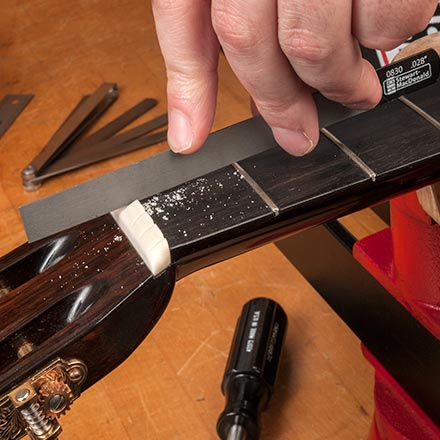
Guitars
&
Guitar Building Blog
The more you know about your guitar the better an artist you will become...Knowlage is Power
Guitar Set Up
Guitar Set Up and maintenance should be viewed like brakes on a car. Every once and a while you need to service the instrument.
Understanding the basics of how a guitar works should be something that every guitar player spends a little time on. To have good tone, intonation and play-ability it is critical that your guitar be properly set up to your playing style.
TRUSS ROD & FRET LEVELING
Almost daily I get a call that sounds something like ".....and my action was too high so I adjusted the truss rod and it didn't really help...."
It should be understood that any time that you make a change to your guitar set up (truss rod, nut or saddle) it will affect ALL other parts of the set up and without a clear understanding of what you are doing the odds are good that you will make things worse and not better.
The first step in a good set up is to loosen the strings, check that the top of the fret board is pointing to the top of the bridge on each side, use the truss rod to straiten the neck (if needed) and then check the level of each fret. Without a flat and level fret board and frets then a great set up will be evasive.
When a guitar string is struck it (very quickly) begins to vibrate toward the fret board and the purpose of the truss rod is to create just enough relief (or bow) to miss the vibrating strings. Thinking of it as anything else will lead you down a path of frustration.
NUT & SADDLE
Before making any adjustments to the guitar nut or saddle you should check the radius of the fret board with relation to the radius of the top of the saddle. You can do this with a radius gauge set.
From here we look at both the string height at the first fret as well as the string height at the twelfth fret. Our goal is to end up with a string height of .018" at the first fret and as close as we can get it to the twelfth fret without buzzing. The height at the twelfth fret should vary depending upon the player style, desire and how well the guitar was built.
Adjusting the height of the bridge should be done first until you are slightly above your desired height at the twelfth fret. To do this you will need a flat sanding surface with adhesive backed sand paper. Sand the bottom of the saddle and check frequently. Now you should begin making adjustments to each fret slot on the guitar nut. Once you slightly above .018" then go back to the saddle and bring it to the desired height at the 12th fret. Once this is done you can make fine adjustments to the nut slot of each string if necessary.
To adjust a guitar nut you will need a set of guitar nut files. Each individual string will need to have it's slot filed until the string height at the first fret is .018".
TRUSS ROD
Put a capo on the first fret and hold down the 6th string at the 12th fret. Now tap on the 6th string at the 7th fret to ensure that there is an ever so slight gap between the string and the 7th fret (no more than .010"). Remove the capo and strike the 6th string, if it buzzes near the middle frets the a slight adjustment to the truss rod will be needed. To make certain that it is the truss rod that needs adjusting press the string at the first fret and strike it again. If you still have a buzz then adjust the truss rod.
INTONATION
Once set up we move on to intonation. Intonation on an acoustic guitar may require a new saddle or possibly even more work on the bridge itself. On an electric guitar most saddles have a way of adjusting the intonation often with individual string saddles. At the twelfth fret the tuning of each string should read the same as the same string played open. If the note reads flat then the distance between the saddle and the twelfth fret needs to be shortened and the reverse is true if it reads sharp.
Intonation can be thrown off by a bad set up or improper truss rod adjustments and so it is important that this step be done last in the set up process.
A NOTE ON HUMIDITY
If you want your guitar to keep its set up then you have to keep up your guitar. Place your guitar in a place that you would be comfortable sitting in all day. In other words, place it away from venting air and direct sunlight. A healthy relative humidity for a guitar is the same as for humans. Somewhere between 40 and 70 percent is where you should be and never above 60 percent for extended periods of time as mold can grow. In my neck of the woods (Virginia Beach, Virginia) the only general need (regarding humidity) is a small inexpensive hygrometer and a 15 dollar humidifier. I am not a fan of keeping a guitar (especially acoustics) in a case and am especially not a fan of "in the case" humidifiers.


